An Efficient Synthesis and Preliminary Investigation of Novel 1,3-Dihydro-2H-benzimidazol-2-one Nitro and Nitramino Derivatives
Abstract
1. Introduction
2. Experimental
2.1. General Methods and Materials
2.2. Synthesis and Properties Investigation of 1,3-Dihydro-2H-benzimidazol-2-one Polynitrocompounds
2.2.1. Synthesis of 4,5,6-Trinitro-1,3-Dihydro-2H-benzimidazol-2-one (TriNBO) (1) in One Step
2.2.2. LC-MS Analysis of the Reaction Product, 4,5,6-Trinitro-1,3-Dihydro-2H-benzimidazol-2-one (TriNBO) (1)
2.2.3. The Main Physicochemical Properties of 4,5,6-Trinitro-1,3-Dihydro-2H-benzimidazol-2-one (TriNBO)
2.2.4. Spectral Properties of TriNBO
2.2.5. Thermal Properties Investigation
2.2.6. Crystal Properties of TriNBO (X-ray Diffraction Structure Analysis)
2.2.7. Preparation of 5-Methyl Analog of TriNBO (Heterocyclic Analog of TNT), 5-Methyl-4,6,7-trinitro-1,3-Dihydro-2H-benzimidazol-2-one (5-Me-TriNBO) (2)
2.2.8. LC-MS-Analysis Data for 5-Me-TriNBO (5-Methyl-4,6,7-trinitro-1,3-dihydro-2H-benzimidazol-2-one (2))
2.2.9. Crystal Properties of 5-Me-TriNBO (2), 5-Methyl-4,6,7-trinitro-1,3-dihydro-2H-benzimidazol-2-one (X-ray Diffraction Structure Analysis)
2.2.10. TriNBO Structure Functionalization for the Synthesis of New Energetic Benzimidazole Nitramines
2.2.11. General Procedure for the Preparation of 5-R-Substituted Nitramines of 4,6-Dinitro-1,3-dihydro-2H-benzimidazol-2-one (3–6)
2.2.12. Thermal Analysis of Selected Nitramines
2.2.13. The Main Physicochemical and Spectral Properties of Synthesized 1,3-Dihydro-2H-benzimidazol-2-one Nitrocompounds and Nitramines
3. Results and Discussion
Calculated Detonation Performance of Benzimidazol-2-one Nitro and Nitramino Derivatives
4. Conclusions
Author Contributions
Funding
Institutional Review Board Statement
Informed Consent Statement
Data Availability Statement
Acknowledgments
Conflicts of Interest
Appendix A
| (A) Intramolecular bond lengths | |
| O19 N17 1.224(6) | O10A C2A 1.236(6) |
| N1 C8 1.380(6) | N14A O16A 1.197(8) |
| N1 C2 1.395(6) | N14A O15A 1.226(7) |
| N1 H1 0.9519 | N14A C6A 1.474(7) |
| O10 C2 1.229(6) | O19A N17A 1.226(5) |
| C9 N3 1.383(7) | N17A O18A 1.211(6) |
| C9 C4 1.375(7) | N17A C7A 1.470(6) |
| C9 C8 1.420(7) | C9A C4A 1.373(7) |
| N17 O18 1.204(6) | C9A N3A 1.383(6) |
| N17 C7 1.427(7) | C9A C8A 1.422(6) |
| N3 C2 1.368(6) | C7A C8A 1.390(7) |
| N3 H3 0.9600 | C7A C6A 1.400(7) |
| C8 C7 1.379(7) | C4A C5A 1.387(7) |
| C7 C6 1.424(7) | C4A H4A 0.9600 |
| C4 C5 1.372(8) | N1A C8A 1.355(6) |
| C4 H4 0.9600 | N1A C2A 1.377(6) |
| C6 C5 1.400(8) | N1A H1A 0.9599 |
| C6 N14 1.495(7) | N3A C2A 1.385(6) |
| N14 O16 1.235(9) | N3A H3A 1.0112 |
| N14 O15 1.222(9) | O12A N11A 1.184(7) |
| C5 N11 1.471(7) | C5A C6A 1.401(7) |
| N11 O13 1.202(8) | C5A N11A 1.493(7) |
| N11 O12 1.233(8) | N11A O13A 1.202(7) |
| (B) Intramolecular bond angles | |
| C8 N1 C2 109.3(4) | O16A N14A O15A 124.6(6) |
| C8 N1 H1 121.4 | O16A N14A C6A 118.8(5) |
| C2 N1 H1 126.5 | O15A N14A C6A 116.6(5) |
| N3 C9 C4 131.8(4) | O19A N17A O18A 123.8(4) |
| N3 C9 C8 107.1(4) | O19A N17A C7A 117.1(4) |
| C4 C9 C8 121.0(4) | O18A N17A C7A 118.9(4) |
| O18 N17 O19 123.3(4) | C4A C9A N3A 131.0(4) |
| O18 N17 C7 120.4(4) | C4A C9A C8A 122.6(4) |
| O19 N17 C7 116.3(4) | N3A C9A C8A 106.4(4) |
| C9 N3 C2 109.7(4) | C8A C7A C6A 120.3(4) |
| C9 N3 H3 119.8 9 | C8A C7A N17A 117.6(4) |
| C2 N3 H3 130.4 | C6A C7A N17A 122.0(4) |
| O10 C2 N3 127.6(4) | C9A C4A C5A 117.1(4) |
| O10 C2 N1 125.2(4) | C9A C4A H4A 120.5 |
| N3 C2 N1 107.2(4) | C5A C4A H4A 122.4 |
| N1 C8 C7 131.8(4) | C8A N1A C2A 109.5(4) |
| N1 C8 C9 106.7(4) | C8A N1A H1A 130.5 |
| C7 C8 C9 121.5(4) | C2A N1A H1A 120.0 |
| C8 C7 N17 121.2(4) | C9A N3A C2A 108.8(4) |
| C8 C7 C6 117.3(4) | C9A N3A H3A 116.4 |
| N17 C7 C6 121.4(4) | C2A N3A H3A 134.5 |
| C5 C4 C9 117.4(4) | O10A C2A N1A 125.8(4) |
| C5 C4 H4 122.6 | O10A C2A N3A 126.8(4) |
| C9 C4 H4 120.1 | N1A C2A N3A 107.4(4) |
| C5 C6 C7 119.1(5) | C4A C5A C6A 122.8(5) |
| C5 C6 N14 121.2(5) | C4A C5A N11A 116.6(4) |
| C7 C6 N14 119.7(4) | C6A C5A N11A 120.6(5) |
| O16 N14 O15 129.3(6) | C7A C6A C5A 118.6(5) |
| O16 N14 C6 115.0(6) | C7A C6A N14A 120.1(4) |
| O15 N14 C6 115.7(6) | C5A C6A N14A 121.3(5) |
| C4 C5 C6 123.4(5) | O13A N11A O12A 125.2(5) |
| C4 C5 N11 116.8(5) | O13A N11A C5A 118.5(5) |
| C6 C5 N11 119.8(5) | O12A N11A C5A 116.2(5) |
| O13 N11 O12 122.9(6) | N1A C8A C7A 133.8(4) |
| O13 N11 C5 121.1(5) | N1A C8A C9A 107.8(4) |
| O12 N11 C5 115.9(6) | C7A C8A C9A 118.3(4) |
Appendix B
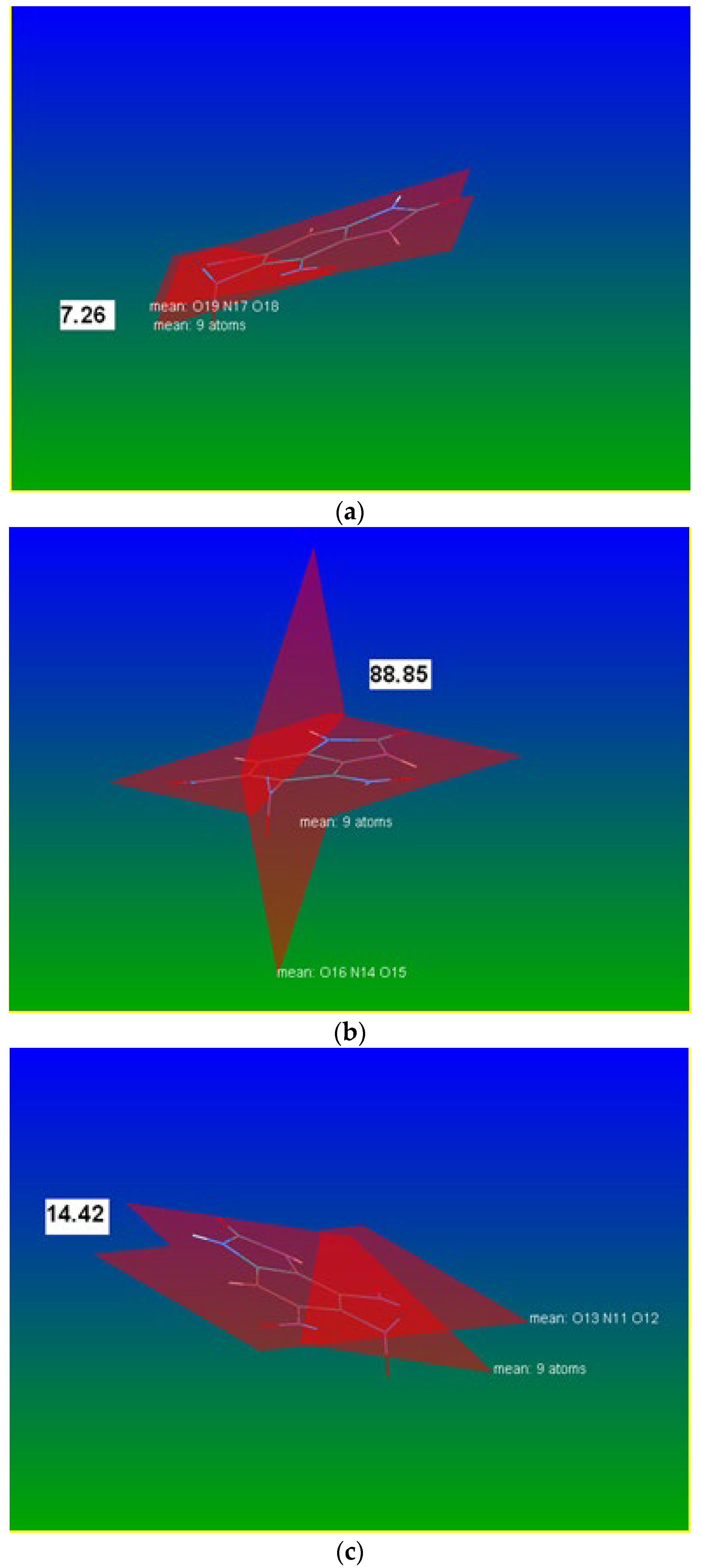
Appendix C
| No. | Compound | Molecular Formula | FT-IR Spectra, (cm−1) | 1H NMR Spectra, (400 Mz, d6-DMSO), ppm |
|---|---|---|---|---|
| 1. | TriNBO | C7H3N5O7 | 3209, 1741, 1643, 1612, 1541, 1488, 1455, 1354, 1330, 1296, 1229, 1194, 1067, 990, 974, 892, 813, 792, 754, 687, 628, 594. | 12.66 (s, 1H, 3-NH). 12.29 (s. 1H, 1-NH) 7.96 (s, 1H, 7-H-Ar). |
| 2. | 5-Me-TriNBO | C8H5N5O7 | 3173, 1737, 1607, 1551, 1424, 1390, 1358, 1332, 1300, 1202, 1075, 1042, 994, 941, 908, 818, 786, 758, 701, 681, 601. | 12.51 (s. 1H, 3-NH). 12.44 (s. 1H, 1-NH), 2.33 (s. 3H, CH3). |
| 3. | 5-MeN(NO2)DNBO | C8H6N6O7 | 3191, 3015, 1742, 1642, 1613, 1539, 1509, 1488, 1436, 1340, 1307, 1196, 1061, 1017, 988, 943, 899, 822, 804, 784, 754, 722, 685, 632, 593. | 12.41 (s. 1H, 3-NH). 12.12 (s. 1H, 1-NH) 7.98 (s, 1H, 7-H-Ar), 3.60 (s, 3H, N-CH3)). |
| 4. | 5-EtN(NO2)DNBO | C9H8N6O7 | 3209, 1741, 1643, 1612, 1541, 1488, 1455, 1447, 1386, 1374, 1354, 1330, 1296, 1229, 1194, 1160, 1139, 1068, 1026, 990, 974, 939, 892, 814, 792, 778, 754, 717, 687, 665, 628, 594, 501. | 12.39 (s. 1H, 3-NH). 12.12 (s. 1H, 1-NH) 7.96 (s. 1H, 7-H-Ar), 4.02 (m. 2H, N-CH2), 1.06 (m. 3H). |
| 5. | 5-PrN(NO2)DNBO | C10H10N6O7 | 3215, 3021, 2964, 2932, 2876, 1742, 1642, 1612, 1541, 1488, 1457, 1438, 1384, 1352, 1329, 1313, 1286, 1195, 1072, 1028, 990, 952, 908, 895, 807, 754, 725, 686, 628, 603. | 12.26 (s. 2H, 1-NH, 3-NH) 7.96 (s, 1H, 7-H-Ar), 3.85 (m, 2H, CH2), 1.45 (m. 2H, CH2,), 0.82 ((m. 3H, CH3). |
| 6. | 5-O2NO(CH2)2N(NO2)DNBO | C9H7N7O10 | 3218, 1744, 1644, 1613, 1542, 1488, 1430, 1348, 1324, 1290, 1194, 1139, 1053, 1016, 989, 969, 933, 892, 837, 802, 781, 754, 718, 689, 631, 506. | 12.32 (s. 1H, 3-NH). 12.11 (s. 1H, 1-NH) 7.95 (s. 1H, 7-H-Ar), 4.03 (m. 4H, N-CH2CH2)). |
References
- Agrawal, J.P.; Hodgson, R. Organic Chemistry of Explosives; John Wiley & Sons, Ltd.: Chichester, UK, 2007; pp. 1–414. [Google Scholar]
- Pagoria, P.F.; Lee, G.S.; Mitchell, A.R.; Schmidt, R.D. A review of energetic materials synthesis. Thermochim. Acta 2002, 384, 187–204. [Google Scholar] [CrossRef]
- Coburn, M.D.; Harris, B.W.; Lee, K.Y.; Stinecipher, M.M.; Heyden, H.H. Explosives synthesis at Los Alamos. Ind. Eng. Chem. Prod. Res. Dev. 1986, 25, 68–72. [Google Scholar] [CrossRef]
- Bagal, L.I.; Pevzner, M.S.; Frolov, A.N.; Sheludyakova, N.I. Heterocyclic compounds. I. Synthesis of nitroderivatives of 1,2,4-triazole, 1,3,4-thiadiazole, tetrazole, 1,3,4-oxadiazole and pyrazole by uncatalitic replacement of diazogroup by nitrogroup. Chem. Heterocycl. Compd. 1970, 4, 259–264. (In Russian) [Google Scholar]
- Ostrovskii, V.A.; Pevzner, M.S.; Kofman, T.P.; Tselinskii, I.V. Energetic 1,2,4-triazoles and tetrazoles: Synthesis, structure and properties. Targets Heterocycl. Syst. 1999, 3, 467–526. [Google Scholar]
- Klapötke, T.M.; Stierstorfer, J. The CN7− Anion. J. Am. Chem. Soc. 2009, 131, 1122–1134. [Google Scholar] [CrossRef]
- Urbanski, T. Chemistry and Technology of Explosives; PWN-Polish Scientific Publishers Warszawa: Warsaw, Poland, 1964; Volume 1, pp. 1–450. [Google Scholar]
- Urbanski, T. Chemistry and Technology of Explosives; PWN-Polish Scientific Publishers Warszawa: Warsaw, Poland, 1964; Volume 4, pp. 1–439. [Google Scholar]
- Stierstorfer, J.; Klapötke, T.M.; Hammerl, A.; Chapman, R.D. 5-Azido-1H-tetrazole—Improved Synthesis, Crystal Structure and Sensitivity Data. Z. Anorg. Allg. Chem. 2008, 634, 1051–1057. [Google Scholar] [CrossRef]
- Klapötke, T.M.; Sabaté, C.M.; Stierstorfer, J. Neutral 5-nitrotetrazoles: Easy initiation with low pollution. New J. Chem. 2009, 33, 136–147. [Google Scholar] [CrossRef]
- Klapötke, T.M.; Sabaté, C.M.; Stierstorfer, J. Hydrogen-bonding Stabilization in Energetic Perchlorate Salts: 5-Amino-1H-tetrazolium Perchlorate and its Adduct with 5-Amino-1H-tetrazole. Z. Anorg. Allg. Chem. 2008, 634, 1867–1874. [Google Scholar] [CrossRef]
- Koldobskii, G.I.; Soldatenko, D.S.; Gerasimova, E.S.; Khokhriakova, N.R.; Scherbinin, M.B.; Lebedev, V.P.; Ostrovskii, V.A. Tetrazoles: Structure and properties of 5-nitrotetrazole. Zh. Org. Khim. 1997, 33, 1854–1857. (In Russian) [Google Scholar]
- Orlova, Y.Y. Chemistry and Technology of High Explosives; Khimija: Leningrad, Russia, 1973; pp. 1–703. (In Russian) [Google Scholar]
- Everest, D. The Power of High Explosives in Theory and Practice; Picatinny Arsenal: Wharton, NJ, USA, 2008; pp. 1–150. [Google Scholar]
- Anusevičius, Ž.; Soffers, A.E.M.F.; Čėnas, N.; Šarlauskas, J.; Segura-Aguilar, J.; Rietjens, I.M.C.M. Quantitative structure-activity relationships for the conversion of nitrobenzimidazoles by DT-diaphorase: Implication for the kinetic mechanism. FEBS Lett. 1998, 427, 325–329. [Google Scholar] [CrossRef]
- Anusevičius, Ž.; Soffers, A.E.M.F.; Čėnas, N.; Šarlauskas, J.; Martinez-Julvez, M.; Rietjens, I.M.C.M. Quantitative structure-activity relationships for the electron transfer reactions of Anabaena PCC 7119 ferredoxin-NADP+ oxidoreductase with nitrobenzene and nitrobenzimidazolone derivatives: Mechanistic implications. FEBS Lett. 1999, 450, 44–48. [Google Scholar] [CrossRef]
- Čėnas, N.; Nemeikaitė-Čėnienė, A.; Šarlauskas, J.; Anusevičius, Ž.; Nivinskas, H.; Misevičienė, L.; Marozienė, A. Mechanisms of the Mammalian Cell Cytotoxicity of Explosives, in Ecotoxicology of Explosives; Sunahara, G.I., Lotufo, G., Kuperman, R.G., Hawari, J., Eds.; CRC Press: Boca Raton, FL, USA; London, UK; New York, NY, USA, 2009; pp. 211–226. ISBN 978-0-8493-2839-8. [Google Scholar]
- Šarlauskas, J.; Dičkancaitė, E.; Nemeikaitė, A.; Anusevičius, Ž.; Nivinskas, H.; Segura-Aguilar, J.; Čėnas, N. Nitrobenzimidazoles as substrates for DT-diaphorase and redox cycling compounds: Their enzymatic reactions and cytotoxicity. Archiv. Biochem. Biophys. 1997, 346, 219–229. [Google Scholar] [CrossRef]
- Efros, L.S.; El‘tsov, A.V. Investigation of benzimidazole. 15. Nitration of benzimidazolone and 1,3-dimethylbenzimidazolone. Zh. Obshch. Khim. 1957, 27, 127–135. (In Russian) [Google Scholar]
- Tselinskii, I.V. Applications of energetic materials in engineering, technology and national economy. Soros Educat. J. 1997, 11, 46–52. [Google Scholar]
- Wright, J.B. The chemistry of the benzimidazoles. Chem. Revs. 1951, 48, 397–541. [Google Scholar] [CrossRef]
- Hofmann, J.B. Imidazole and Its Derivatives; Part 1; Wiley-Interscience: New York, NY, USA, 1953; pp. 1–648. [Google Scholar]
- Preston, N. Synthesis, reactions, and spectroscopic properties of benzimidazoles. Chem. Revs. 1974, 74, 279–314. [Google Scholar] [CrossRef]
- Stefaniak, L.; Kamienski, B.; Voronkov, M.G.; Larina, L.I.; Lopyrev, V.A.; Webb, G.A. Investigation of Benzimidazolones. Part 7: A 13C and 15N NMR Study of Some Nitro Benzimidazolones. Bull. Pol. Acad. Sci. Chem. 1991, 396, 317–319. [Google Scholar]
- Larina, L.; Lopyrev, V. Topics in Applied Chemistry. Nitroazoles: Synthesis, Structure and Applications; Springer: New York, NY, USA, 2009; pp. 1–441. ISBN 978-0-387-98070-6. [Google Scholar]
- Patai, S. (Ed.) The Chemistry of Amino, Nitro and Nitroso Compounds; John Wiley & Sons: London, UK, 1982; pp. 1–728. ISBN 10: 0471278718. [Google Scholar]
- Benchidmi, M.; El Kihel, A.; Essassi, E.M.; Knouzi, N.; Toupet, L.; Danion-Baugot, R.; Carrie, R. Nitration of substituted benzimidazoles. Bull. Soc. Chim. Belg. 1995, 10, 605–611. [Google Scholar]
- Freyer, A.J.; Lowema, C.K.; Nissan, R.A.; Wilson, W.S. Synthesis and Explosive Properties of Dinitropicrylbenzimidazoles, and the ‘Trigger Linkage’ in Dinitropicrylbenzotriazoles. Austral. J. Chem. 1992, 45, 525–539. [Google Scholar] [CrossRef]
- Grimmett, M.R. Imidazole and Benzimidazole Synthesis (Best Synthetic Methods); Academic Press: London, UK, 1997; pp. 1–265. ISBN 0123031907. [Google Scholar]
- Kaiya, T.; Nakamura, K.; Tanaka, M.; Miyata, N.; Kohda, K. Product Analyses of Ozone Mediated Nitration of Benzimidazole Derivatives with Nitrogen Dioxide: Formation of 1-Nitrobenzimidazoles and Conversion to Benzotriazoles. Chem. Pharm. Bull. 2004, 52, 570–576. [Google Scholar] [CrossRef][Green Version]
- Holleman, A.F.; Wiberg, E.; Wiberg, N. (Eds.) Inorganic Chemistry; Academic Press/De Gruyter: San Diego, CA, USA; Berlin, Germany, 2001; ISBN 0-12-352651-5. [Google Scholar]
- Schindlbauer, H.; Kwiecinski, W. Direct nitration of benzimidazolone and reaction of some of the nitration products. Monatsh. Chem. 1976, 107, 1307–1310. [Google Scholar] [CrossRef]
- Clark, R.L.; Pessolano, A.A. Synthesis of Some Substituted Benzimidazolones. J. Am. Chem. Soc. 1958, 80, 1657–1664. [Google Scholar] [CrossRef]
- Šarlauskas, J.; Sergedienė, E.; Nemeikaitė-Čėnienė, A.; Nivinskas, H.; Ačaitė, J.; Čėnas, N. Cytotoxicity of new bifunctional nitrobenzimidazoles. Acta Med. Litu. 2000, 1, 62–66. [Google Scholar]
- Clarkson, C.E.; Holden, I.G.; Malkin, T. 322. The nitration of dimethylaniline to tetryl, 2: 4: 6: N-tetranitro-methylaniline. The course of the reaction. J. Chem. Soc. 1950, 1556–1562. [Google Scholar] [CrossRef]
- Naixing, W.; Boren, C.; Yuxiang, O. Review on Benzofuroxan System Compounds. Propellants Explos. Pyrotech. 1994, 19, 145–148. [Google Scholar] [CrossRef]
- Naixing, W.; Boren, C.; Yuxiang, O. Synthesis of N,N’-bis-(2-nitrobenzodifuroxanyl)-3,5-dinitro-2,6-diaminopyridine. Propellants Explos. Pyrotech. 1992, 17, 265–266. [Google Scholar] [CrossRef]
- Türker, L. Velocity of detonation-a mathematical model. Acta Chim. Slov. 2010, 5, 288–296. [Google Scholar]
- Kamlet, M.J.; Jacobs, S.J. Chemistry of Detonations. I. Simple Method for Calculating Detonation Properties of CHNO Explosives. J. Chem. Phys. 1968, 48, 23–55. [Google Scholar] [CrossRef]
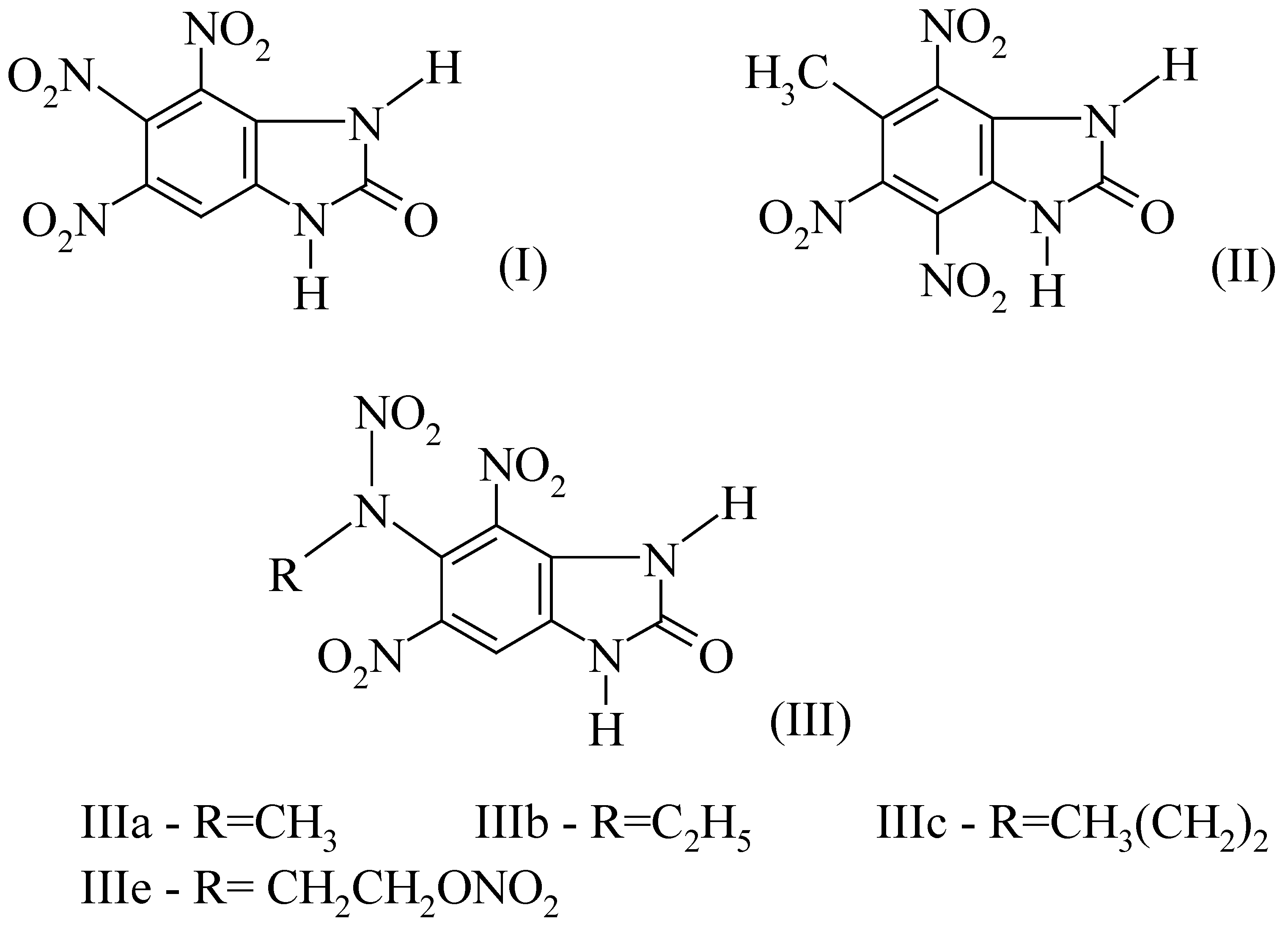

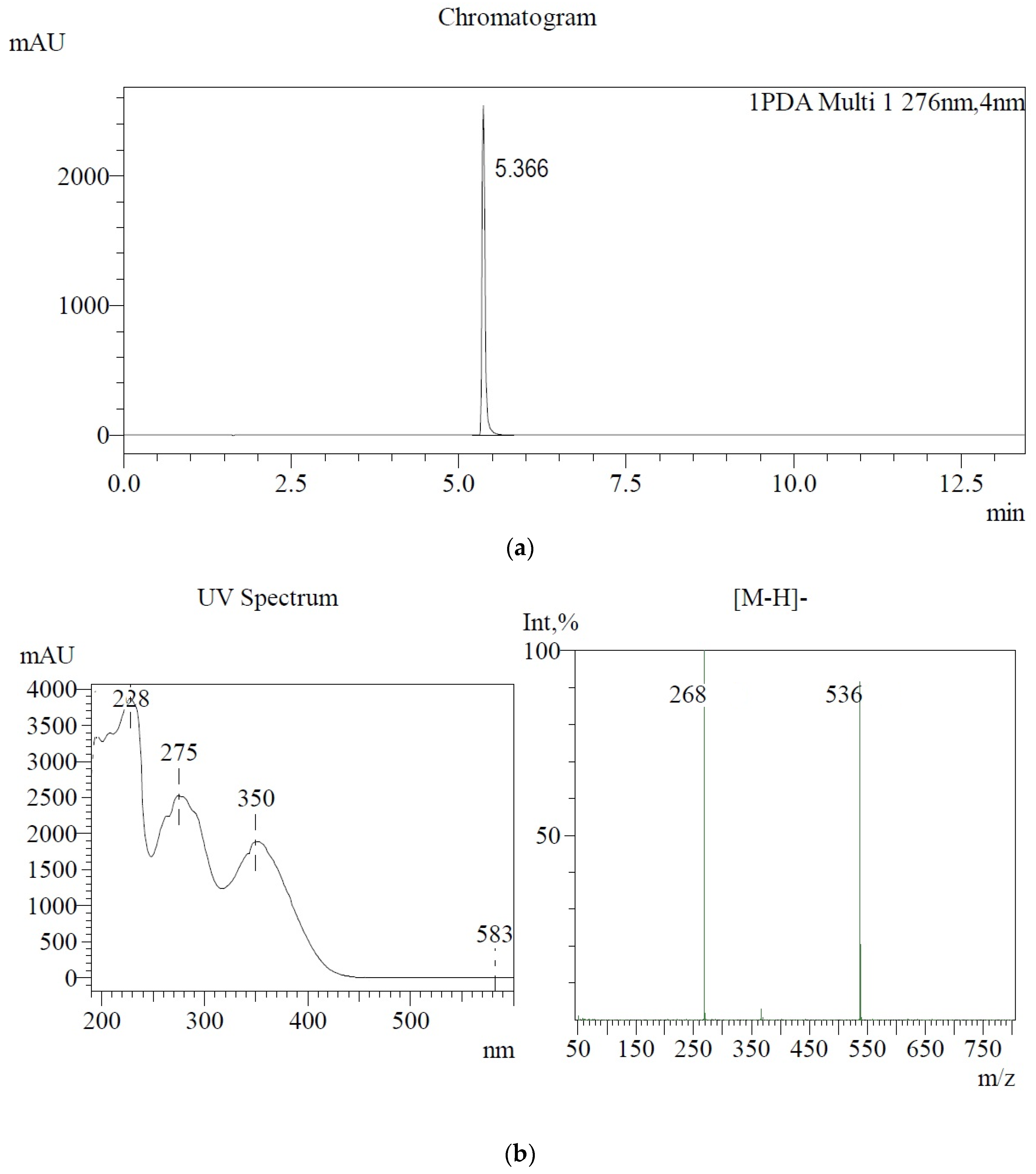
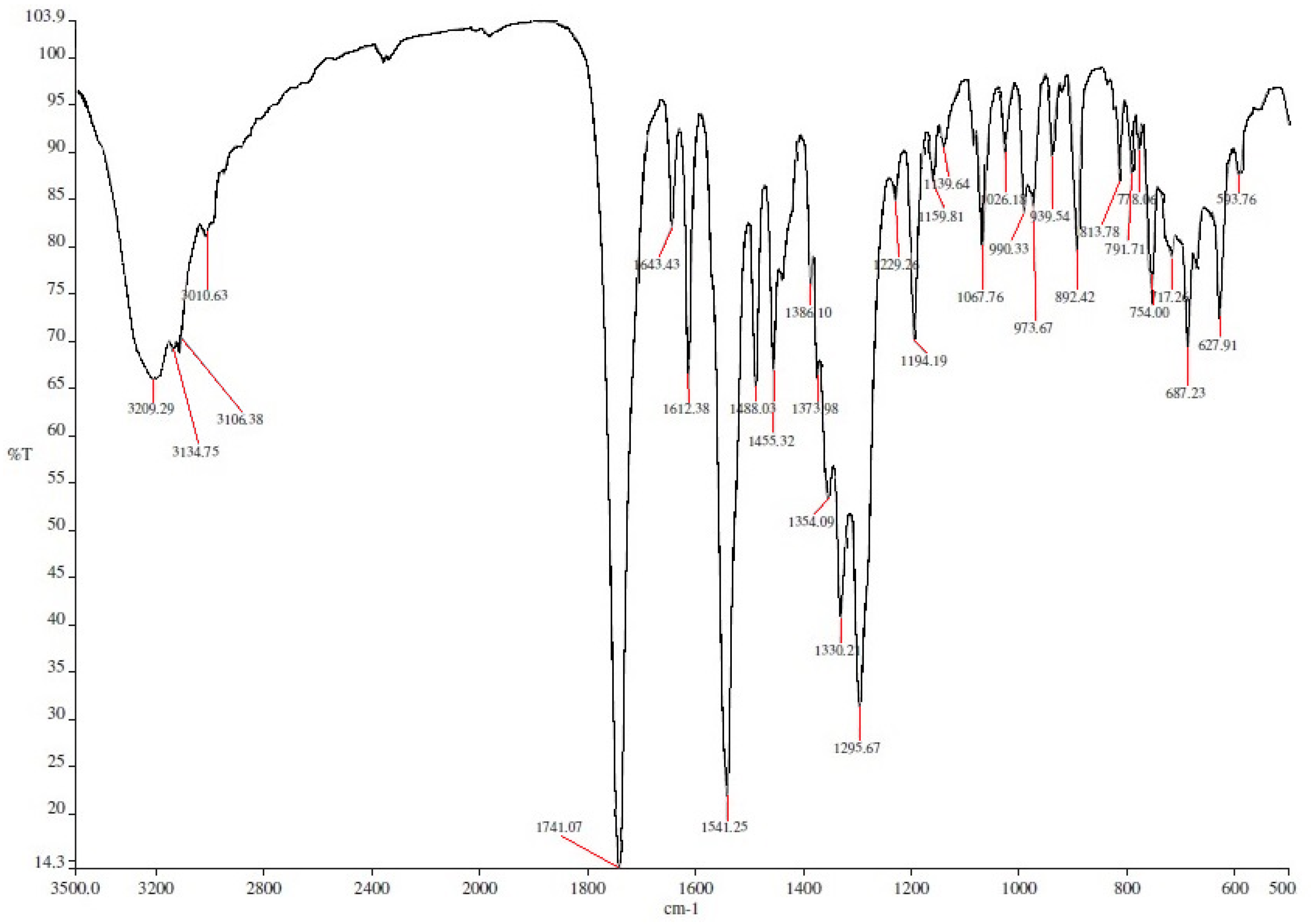

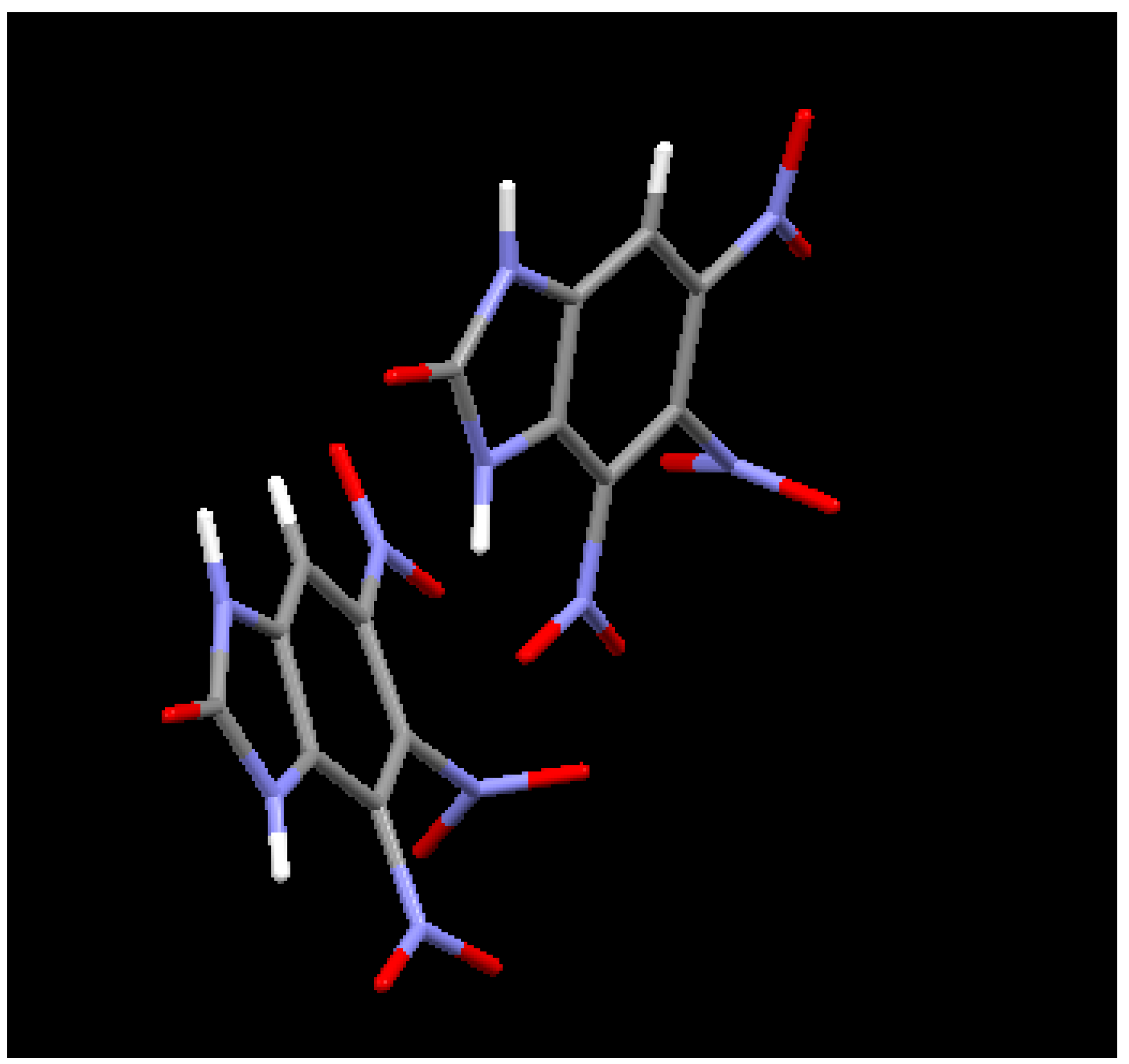
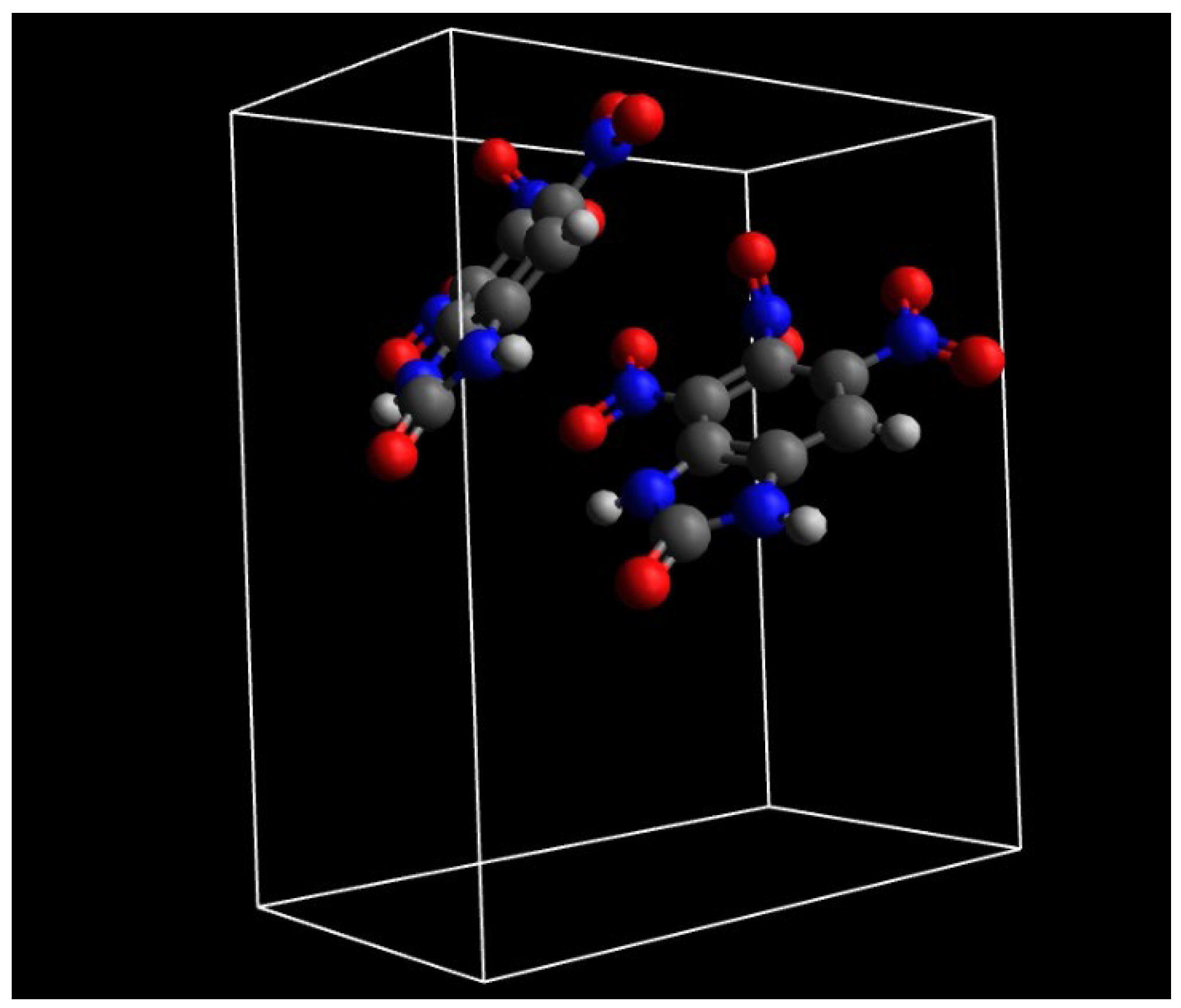


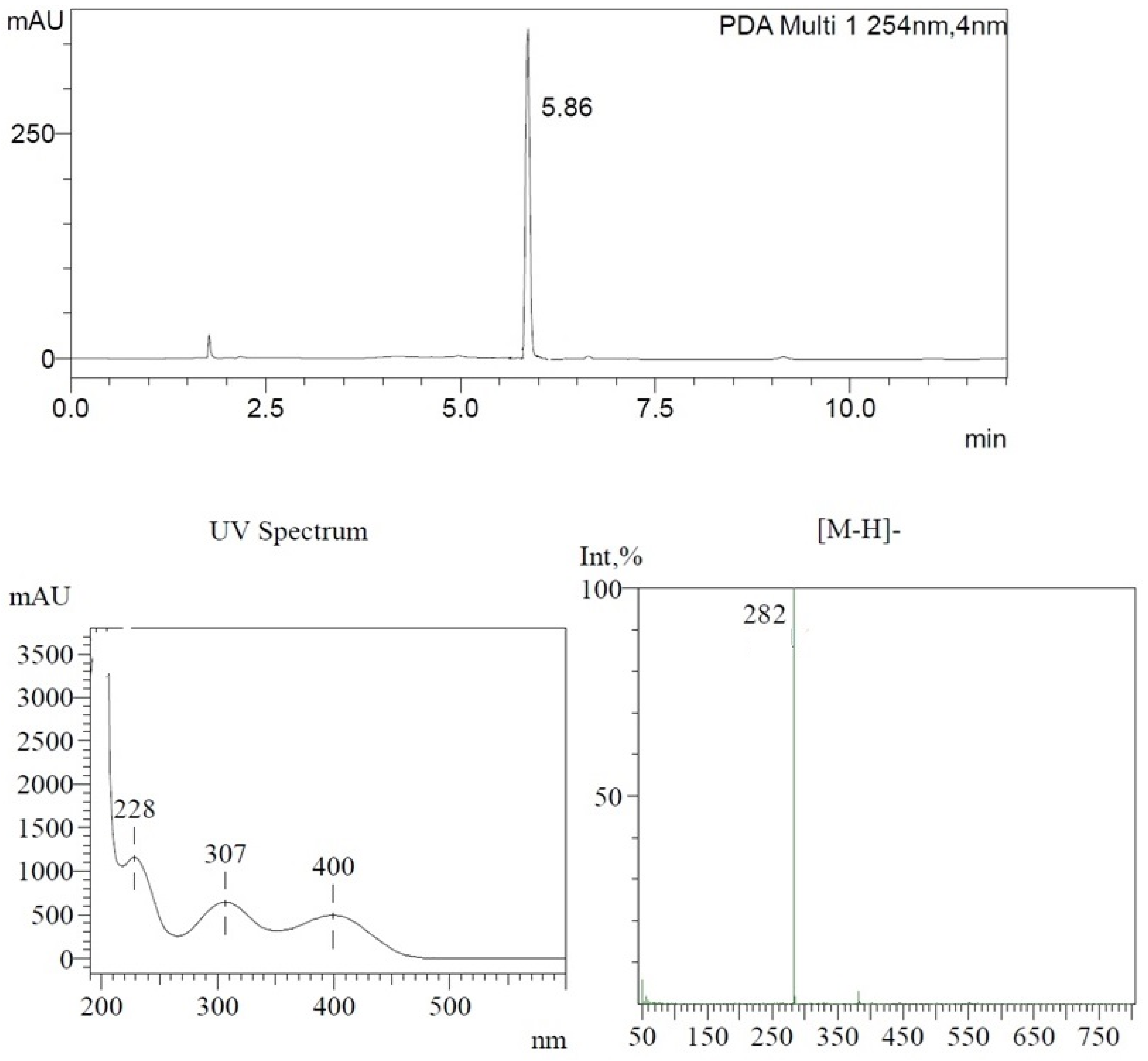
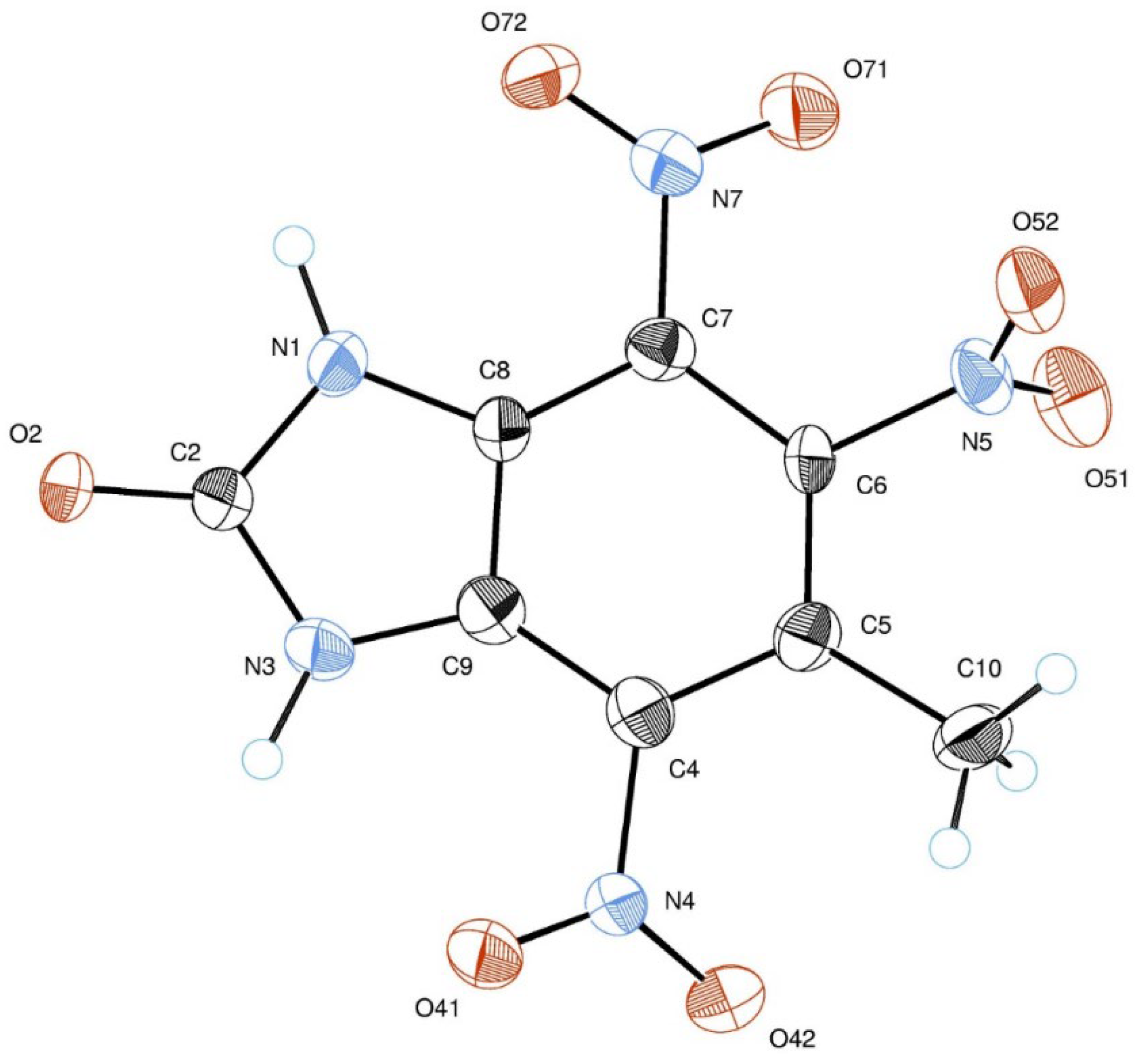

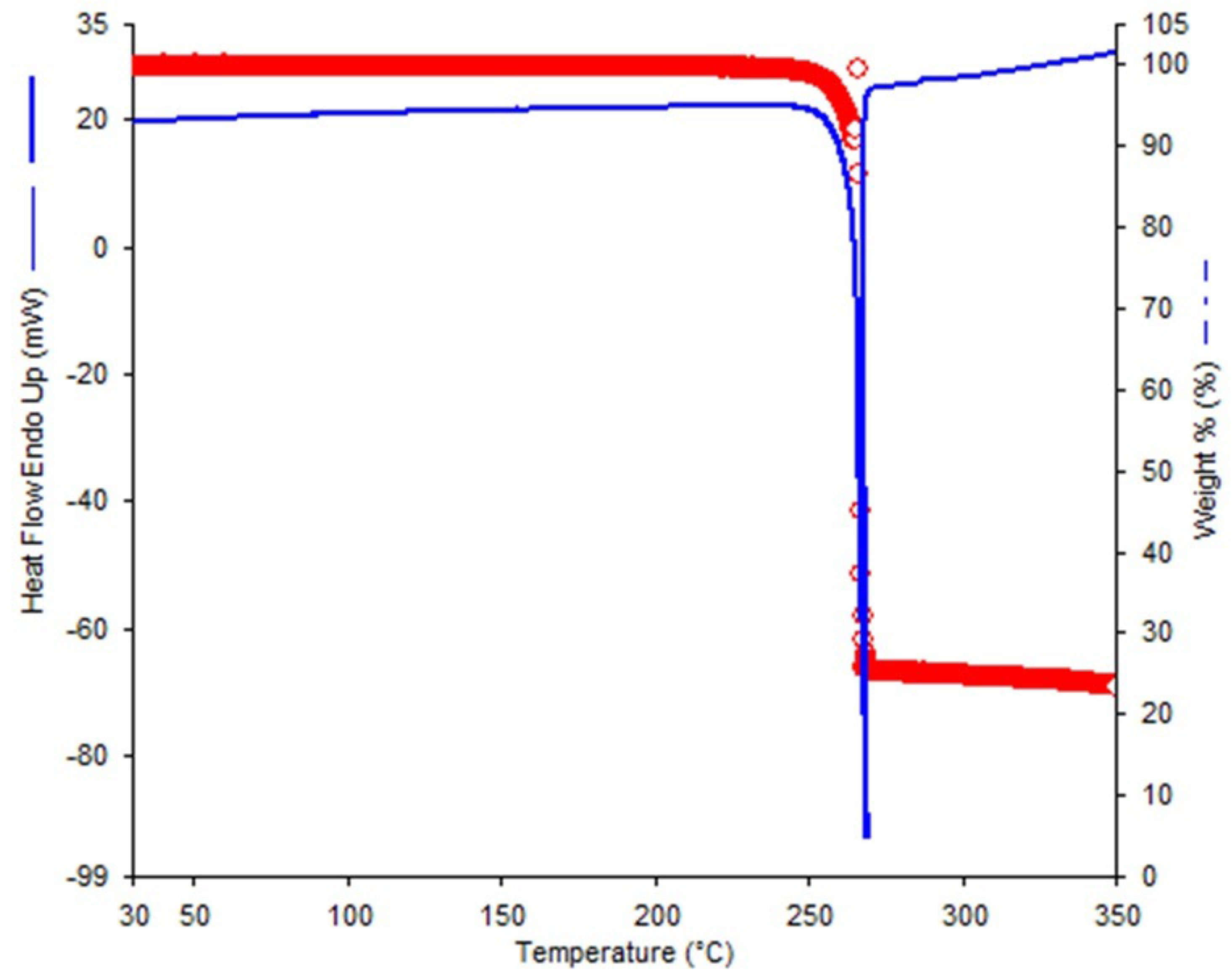
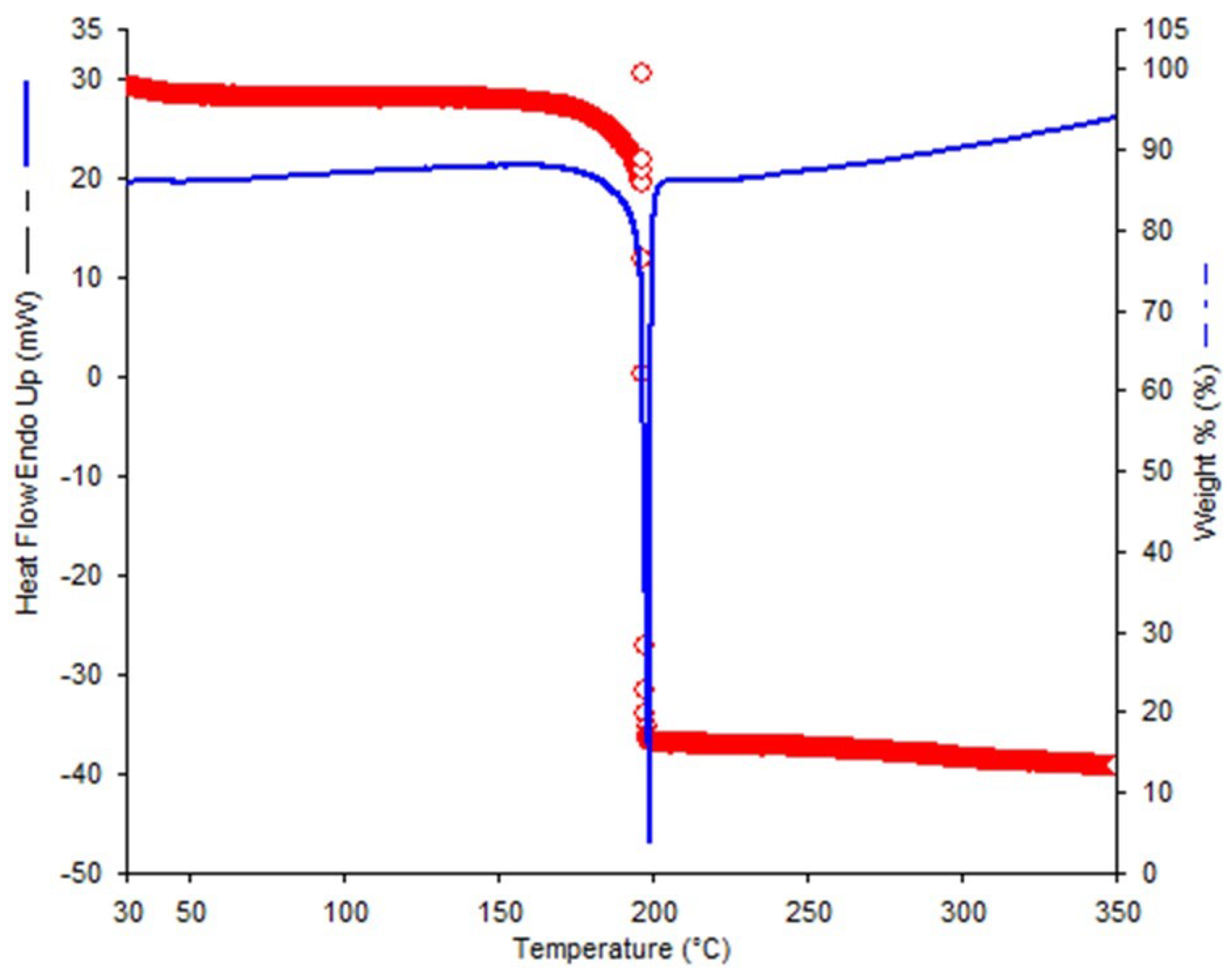
| Empirical formula | C7H3N5O7 |
| Formula weight | 269.14 |
| Temperature | 173(2) K (−100 °C) |
| Wavelength | 0.71073 Å |
| Crystal system | Orthorhombic |
| Crystal description | Yellow prism |
| Space group | P 2 21 21 |
| Unit cell dimensions | a = 7.3420(5) |
| A alpha = 90.0 deg. | |
| b = 16.1900(2) A beta = 90.0000(12) deg. | |
| c = 17.0200(6) A gamma = 90.0 deg. | |
| Volume | 2023.12(16) Å3 |
| Z | 8 |
| Density (calculated) | 1.767 g/cm3 |
| Density (measured, pycnometer) | 1.76 g/cm3 |
| Absorption coefficient | 0.161 mm−1 |
| F(000) | 1088 |
| Crystal size | 0.27 × 0.22 × 0.15 mm |
| Two theta max. for data | 28.0 deg. |
| Reflections collected | 9135 |
| Independent reflections | 4800 |
| Refinement method | Full-matrix least-squares on F2 |
| R indices (all data) | R1 = 0.1010, wR2 = 0.2141 |
| Empirical formula | C8H5N5O7 |
| Formula weight | 283.17 |
| Temperature | 193(2) K (−80.15 °C) |
| Wavelength | 0.71073 Å |
| Crystal system | Monoclinic |
| Crystal description | Red plate |
| Space group | P 21/c |
| Unit cell dimensions | a = 4.8952(5) |
| A alpha = 90.0 deg. | |
| b = 14.7707(18) A beta = 93.253(6) deg. | |
| 14.3037(19) A gamma = 90.0 deg. | |
| Volume | 1032.6(2) Å3 |
| Z | 4 |
| Density (calculated, (−80 °C) from X-Ray data) | 1.822 g/cm3 |
| Density (measured, (20 °C) pycnometer) | 1.78 g/cm3 |
| Absorption coefficient | 0.163 mm−1 |
| F(000) | 576 |
| Crystal size | 0.33 × 0.212 × 0.02 mm |
| Refinement method | Full-matrix least-squares on F2 |
| Measurement device | ‘Bruker–Nonius KappaCCD’ |
| No. | Abbreviation and Chemical Name | Mol. Formula | Mol. Weight | LC-MS Data | Yield, (%) | M.p. (°C) |
|---|---|---|---|---|---|---|
| 1 | TriNBO, 4,5,6-Trinitro-1,3-dihydro- benzimidazol-2-one | C7H3N5O7 | 269.13 | R.T. = 5.37 min, UV, λmax = 275, 350. [M-H]− =268 2[M-H]− = 536. | 83.0 | 314-5 (dec.) |
| 2 | 5-Me-TriNBO, 5-Methyl-4,6,7-trinitro-1,3-dihydrobenzimidazol-2-one | C8H5N5O7 | 283.16 | R.T. = 5.86 min, UV λmax = 307, 400. [M-H]− =282 | 89.8 | 270-2 (dec.) |
| 3 | 5-MeN(NO2)DNBO, 5-Methylnitramino-4,6-dinitro-1,3-dihydrobenzimidazol-2-one | C8H6N6O7 | 298.13 | R.T. = 5.58 min, UV λmax = 279, 351. [M-H]− = 297 [2M-H]− = 595. | 85.0 | 278-9 (deflagr.) |
| 4 | 5-EtN(NO2)DNBO, 5-Ethylnitramino-4,6-dinitro-1,3-dihydrobenzimidazol-2-one | C9H8N6O7 | 312.20 | R.T. = 5.61min, UV λmax = 280, 353. [M-H]− = 311 [2M-H]− = 623. | 87.3 | 271-3 (dec.) |
| 5 | 5-PrN(NO2)DNBO, 5-Propylnitramino-4,6-dinitro-1,3-dihydrobenzimidazol-2-one | C10H10N6O7 | 329.23 | R.T. = 5.37min, UV λmax = 275, 350. [M-H]− = 326 [2M-H]− = 653. | 78.1 | 261-3 (dec.) |
| 6 | 5-O2NO(CH2)2N(NO2) DNBO, 5-[2′-(Nitroxyethyl)nitramino]- 4,6-dinitro-1,3-dihydrobenzimidazol-2-one | C9H7N7O10 | 373.20 | R.T. = 5.37min, UV λmax = 275, 350. [M-H]− = 372 [2M-H]− = 545 [M-NO2]− = 326 | 73.0 | 199-201 (deflagr.) |
| No. | Compound | Molecular Formula | Calc. Density (g/cm3) | Oxygen Balance, (Ω), OBCO2, % | Velocity of Detonation, Calc. (D, (m/s)) | Detonation Pressure, Calc., P (kbar) |
|---|---|---|---|---|---|---|
| 1. | TriNBO | C7H3N5O7 | 1.767 (at173K temp.) or 1.76 (exp., pycnom.) | −50.52% | 7900 | 284 |
| 2. | 5-Me-TriNBO | C8H5N5O7 | 1.822 (at193 K temp.) or 1.82 (exp., pycnom.) | −64.98 | 7460 | 245 |
| 3. | 5-MeN(NO2)DNBO | C8H6N6O7 | 1.806 | −64.39 | 7370 | 240 |
| 4. | 5-EtN(NO2)DNBO | C9H8N6O7 | 1.719 | −76.87 | 6980 | 209 |
| 5. | 5-PrN(NO2)DNBO | C10H10N6O7 | 1.647 | −87.47 | 6800 | 194 |
| 6. | 5-O2NO(CH2)2N(NO2)DNBO | C9H7N7O10 | 1.859 | −68.78 | 7570 | 253 |
| 7. | TNT (as standard) | C7H5N3O6 | 1.630 (exp.) | −73.98 | 6900 | 210 (exp.) |
| 8. | Tetryl (as standard) | C7H5N5O8 | 1.73 (exp.) | −47.40 | 7570 | 260 (at 1.71g/cm3) (exp.) |
Publisher’s Note: MDPI stays neutral with regard to jurisdictional claims in published maps and institutional affiliations. |
© 2022 by the authors. Licensee MDPI, Basel, Switzerland. This article is an open access article distributed under the terms and conditions of the Creative Commons Attribution (CC BY) license (https://creativecommons.org/licenses/by/4.0/).
Share and Cite
Šarlauskas, J.; Stankevičiūtė, J.; Tamulienė, J. An Efficient Synthesis and Preliminary Investigation of Novel 1,3-Dihydro-2H-benzimidazol-2-one Nitro and Nitramino Derivatives. Materials 2022, 15, 8330. https://doi.org/10.3390/ma15238330
Šarlauskas J, Stankevičiūtė J, Tamulienė J. An Efficient Synthesis and Preliminary Investigation of Novel 1,3-Dihydro-2H-benzimidazol-2-one Nitro and Nitramino Derivatives. Materials. 2022; 15(23):8330. https://doi.org/10.3390/ma15238330
Chicago/Turabian StyleŠarlauskas, Jonas, Jonita Stankevičiūtė, and Jelena Tamulienė. 2022. "An Efficient Synthesis and Preliminary Investigation of Novel 1,3-Dihydro-2H-benzimidazol-2-one Nitro and Nitramino Derivatives" Materials 15, no. 23: 8330. https://doi.org/10.3390/ma15238330
APA StyleŠarlauskas, J., Stankevičiūtė, J., & Tamulienė, J. (2022). An Efficient Synthesis and Preliminary Investigation of Novel 1,3-Dihydro-2H-benzimidazol-2-one Nitro and Nitramino Derivatives. Materials, 15(23), 8330. https://doi.org/10.3390/ma15238330






